 1981 Bollinger Grande Annee
1981 Bollinger Grande Annee
(70% Pinot Noir, 30% Chardonnay;
disgorged October 14, 1999; $175-$225 US)
This is a controversial wine that I have never been a fan of. Bollinger
originally planned to release a 1981 Grande Annee, but the wine didnít
come around quite right as it was too acidic and bitter for a vintage
release. But, they had bottles of it ready to go so they gave it a
shot anyway. They decided to test it on the Italian market where it was
a failure and eventually recalled. This left Bollinger with lots of wine
so they decided to get rid of it by waiting on it and releasing it as an
RD. They should have gotten rid of the wine in some other way because
this is horrible for the price. It has always been a C+/B- wine
to me and this was the case again tonight. It shows good amounts of
upfront fruit and a generous dose of toast, but then it just fades into
a thin acidic mixture that I donít like. Grade
of low B- (79-81 pts). Find this wine
All of the Bollinger Champagnes were interesting and nice to
drink, but they left me lacking a bit as I didnít think any was on top
of its game. Brad Cook, noted
Bollinger drinker extraordinaire, commented that all
were nice, but none really moved him or showed the highs that
Bollinger is capable of achieving. I would say he called it perfectly.
The Chardonnays
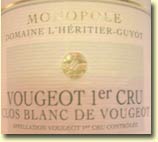 1992 Domaine LíHeritier-Guyot Clos Blanc de Vougeot Premier Cru
1992 Domaine LíHeritier-Guyot Clos Blanc de Vougeot Premier Cru
I donít drink nearly enough white Burgundy and always enjoy it when I
do. This shows well for its age and really contrasts the wine
below. It isnít anything that will knock you out, but it is enjoyable. I
liked the fresh citrus character and found subtle hints of coconut and
pineapple in the mix as well. I donít think it is worth the price of
admission (this vintage would be around $60 US), but I will take a
glass. Grade of Low B (82-85 pts). Find this wine
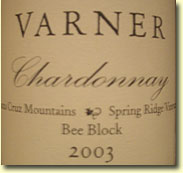 2003 Varner Bee Block Chardonnay
2003 Varner Bee Block Chardonnay
(Santa Cruz Mountains, CA; 50% of the wine sees new French oak; 14 year
old vines; $35-$40 US)
I love all the wines that Varner makes. From the low end Foxglove
Chardonnay to the Hidden Block Pinot and back to the higher end Varner
Chardonnay selections, these are all great values in my book. The
2003 Bee Block is quite rambunctious and shows very big next to the
Burgundy above. Errol Kovitch and
Jim Friedman call it oaky, but I like
it. It isnít overdone, but rather full of citrus, baking spice, and a
wonderful warming cinnamon laced finish. Warm or cold, this wine shows
well and is right up my alley. Let it breathe after opening and you will
be rewarded. Jeff Cassetta and Karwyn Abrams
both noted that if the bottle says Santa Cruz Mountains Chardonnay it is
probably going to be good. High B+ (88-90 pts). Find this wine
The Main Event Ė Favia
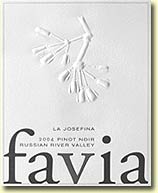 2004 Favia La Josefina Russian River Valley Pinot Noir
2004 Favia La Josefina Russian River Valley Pinot Noir
(100% Pinot Noir; Russian River
Valley, CA; 10 months in French Oak; No fining or filtering; 220 cases
produced; $65-$85 US)
This is the second vintage of this wine. Favia talks of how they aimed
to cross new world and traditional Burgundian practices in making this
and I think they did a very fine job. I picked up baking spices, lightly
candied cherries and plums. I found it quite flavorful and a nice
mix of French and California Pinot flavors. I seemed to be in the
minority here as the rest of the group found this a bit hot. This was
actually my second favorite of the Favias and while it might be a bit
pricey, I donít think it is a bad deal. Grade
of low A- (89-91 pts). Find this wine
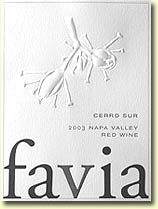 2003 Favia Cerro Sur Napa Valley Red Wine
2003 Favia Cerro Sur Napa Valley Red Wine
(85% Cab Franc; 15% Cabernet
Sauvignon; Napa Valley, CA; 25 year old vines; 22 months in French oak;
No fining or filtering; 230 cases produced; $65-$85 US)
Favia says that this wine is part Napa Valley, part Chateauneuf-du-Pape.
Iím not exactly sure where they get that idea from, but, hey, whatever.
I did find this a very nice Cab Franc dominant blend. There was plenty
of green herbal notes to go with some ripe red cherry notes. Baking
spice and cherry laced biscuits help bring the main flavor components to
a close. On the finish, I pick up quite a bit of green stems and a
something similar to glue. While I donít like the green stems that much,
the glue notes are not a negative in this wine. Every now and then a
good shot of glue is just what the doctor ordered. Kindergarten students
around the world would approve. This is a nice wine, but maybe not nice
enough for the price. Grade of High B+ (88-90
pts). Find this wine
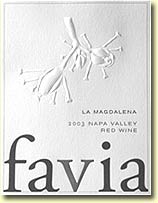 2003 Favia La Magdalena Napa Valley Red Wine
2003 Favia La Magdalena Napa Valley Red Wine
(50% Cabernet Franc, 50% Cabernet
Sauvignon; Napa Valley, CA; 22 months in French Oak; 90 cases produced;
$65-$85 US)
This wine is Faviaís Bordeaux inspired wine (though I donít think it
tastes much like Bordeaux). It has been made in one version or another
since 1998 (unreleased to the public until now). It is extremely smooth
on the palate and full of brambly fruit. It isnít a big styled wine, but
rather a smooth and fruit forward one. It isnít quite my style, but I
can understand the raves for it. It was the clear favorite among
all for the best of the Favias. Comments like, ďThis is so smoothĒ,
ďExcellent stuffĒ, ďFruity tanninsĒ, and ďWow, this is goodĒ abounded. I
did like the tannic structure of this wine so perhaps this will change
more to my liking with age. While I was not as big a fan as the others,
I did think this was well made and showed excellent potential. If I only
could only choose one Favia, I would hedge my bets on this one.
Grade of A- (90-92 pts). Find this wine
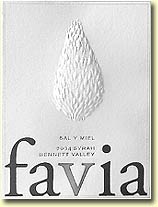 2004 Favia Sal y Miel Bennett Valley Syrah
2004 Favia Sal y Miel Bennett Valley Syrah
(100% Syrah; Bennett Valley, CA; 75 cases produced; $65-$85 US)
This is a big and tannic syrah that is full of raspberry flavors. It is
a bit too dry and tannic for me and I wonder if the fruit will ever come
out or if it will stay dark and tannic forever. It is unlike most
California syrahs that I have had as the fruit is not in the fore as a
youngster. Among the Favias this seemed to get lost as no one really
loved it, but no one disliked it either. If the fruit can open up a bit
and some spicy dark notes come about, this could be a very nice wine.
Grade of Low B+ (86-88 pts).
Find this wine
A Bunch Of Other Red Crap
 2001 Pride Cabernet Sauvignon
2001 Pride Cabernet Sauvignon
(100% Cabernet Sauvignon; Napa Valley,
CA; Aged in French oak; $60-$70 US)
If there was one wine that got lost in the crowd, it was this one. No
one really loved it, but no one really disliked it. It just seemed to be
lacking. Errol Kovitch called it green and many others thought it would
have fared better on its own. I found the wine to show plenty of
blueberry and dark raspberry notes, but also thought it was bit too
fruit forward for my palate and it just got lost between the Favias, the
Shafers, the Montrose, and even the Mitolo GAM which all seemed to pull
off a better balancing act of fruit, oak and making a ďlook at meĒ
statement. Grade of Solid B (85-86 pts). Find this wine
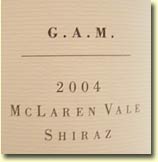 2004 Mitolo GAM Shiraz
2004 Mitolo GAM Shiraz
(100% Shiraz; McLaren Vale, South
Australia; 18 months in 70% new French oak and 30% second use American
oak; Screwcapped; $35-$55 US)
Karwyn Abrams brought this bottle to the party and what a good choice it
was. I always find the GAM to be one of the more elegant big Aussie
fruit monsters (relatively speaking), but next to the other wines served
tonight this was huge in fruit and oak. Yet, it kept everything under
control and was so velvety and sweet in the mouth with raspberry,
vanilla oak, and blackberry that I couldn't help but enjoy it. It stood
out in the crowd, but it was proud to be different.
Grade of High B+ (88-90 pts). Find this wine
 1990 Montrose
1990 Montrose
(Typically 65% Cabernet Sauvignon, 25%
Merlot, 10% Cabernet Franc with 18-19 months in French oak with 30% of
it new; Saint Estephe, Bordeaux, France; Second growth; $300-$450 US)
This was the most controversial wine of the night. Jim Friedman said it
smelled like the Palmer Park riding stables. Paul Ragheb (who provided
the wine) thought it was sexy as hell. On and on like this it went. I
loved the wine; it was full of dark cherries, tobacco, leather, and a
dose of one fine horse. It kept opening up in the glass and gaining more
and more complexity over time as the dark tannins meshed perfectly with
the tobacco and leather notes. It was my Wine of the Night (WOTN) and
was the choice of many others too. Grade of A
(93-96 pts). Find this wine
2001 Shafer Hillside Select Cabernet Sauvignon
(100% Cabernet Sauvignon; Stags Leap
District, Napa Valley, CA; 32 months in new French oak; 14.9% alc;
$300-$350 US)
Full of tannic and backward fruit, this is monstrous wine that has
plenty of ammunition in store for the future. It shows lots of dark,
sweet dusty tannins along with black fruit and a smooth blackberry and
smoke finish that haunted me through the night. The oak is there, but it
isnít obtrusive to me. This is exactly the style of California wine that
I like. It needs time to show everything it has to offer but was very
good tonight and along with the 1990 Montrose stood head and shoulders
above the rest. Karwyn Abrams noted that both this wine and the wine
below left him hit-mo-tized yet again.
Grade of A (93-96 pts). Find this wine
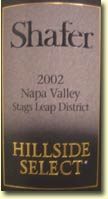 2002 Shafer Hillside Select Cabernet Sauvignon
2002 Shafer Hillside Select Cabernet Sauvignon
(100% Cabernet Sauvignon; Stags Leap
District, Napa Valley, CA; 32 months in new French oak; 14.9% alc;
$300-$400 US)
Next to the 2001, this shows jammy and fruity. It is very fruit forward
with blueberry and vanilla showing a bit too much oak for my liking. I
wish there was a bit more tannin and darkness to this wine, but I think
the future will bring that along. I preferred the 2001 tonight, but this
is very good. Jeff Cassetta summed up the 2001 and 2002 Shafers
well when he said that they were good wines that will get better, but
asked if they really worth what people are paying for them right now. An
excellent question and one that I agree with. I enjoyed both Hillsides,
but I can find wines for less money that I enjoy just as much. Still, it
is nice to taste these. Grade of Solid A-
(91-92 pts). Find this wine
Some Sweet Stuff
 2002 Sine Qua Non Mr. K The Nobleman
2002 Sine Qua Non Mr. K The Nobleman
(Botrytis Chardonnay; California; 321
g/L of residual sugar; 10.25 /L of acidity; $80-$120 US per half bottle)
This is one sweet and thick concoction that shows caramel apples, brown
sugar, and candied apricots, all on steroids. There is a small hint of
citrus in the back, but this is one sweet wine. Both Jeff Cassetta and
Errol Kovitch remarked that it didnít seem to show much complexity or
have the acidity to age, but it is a fun glass. Overall, I think the
price is high and I prefer (in price and quality) the
Andersonís Conn
Valley Botrytis Chardonnay at half the price, but this is enjoyable.
Grade of Solid A- (91-92 pts). Find this wine
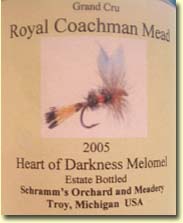 2005 Royal Coachman Mead Heart of Darkness Melomel
2005 Royal Coachman Mead Heart of Darkness Melomel
(Troy, Michigan; 14.5% alc)
This bottle was made and brought by noted Mead expert
Ken Schramm. Iíve
had a few bottles of Mead in my life, but nothing to make me really sit
up and take interest. This bottle did. To me it smelled like honey
thrown over a lilac bush. In my mouth, it was sweet lavender, a nice
citrus acidity, and tons of powerful floral notes. The crowd found
lilacs, lavender, and lilies and they are all in there. I donít know if
I could drink a bottle of this, but a glass is quite nice and very
interesting. How do you grade this? I donít know, but I will put it on a
Pass/Fail scale. Grade of Pass (somewhere
between 70-100 pts). Find this wine
Overall, I had a great night and was even able to get up the next
morning thanks to the ample amount of water that was supplied with the
wine. As for the Faviaís, I donít think I would buy, but
considering the people involved and the price that other similar
boutique wines are getting, it is one of the more reasonable offerings
out there. All of the wines are well made and will be interesting to try
over time.
Cheers!
Brad Baker
BACK TO THE TOP
BACK
TO BRAD BAKER'S INDEX PAGE
© Brad Baker